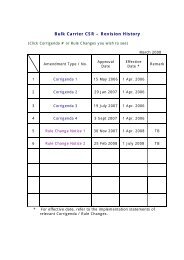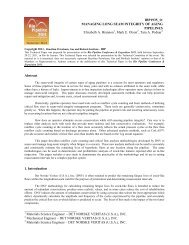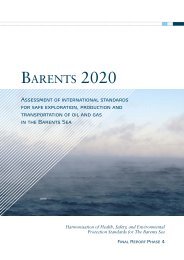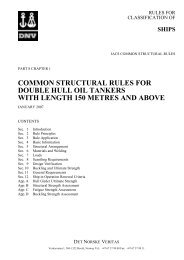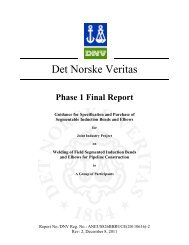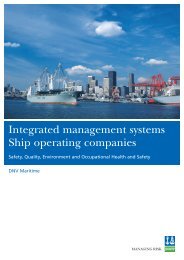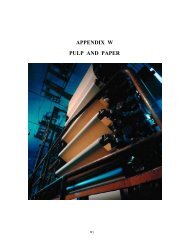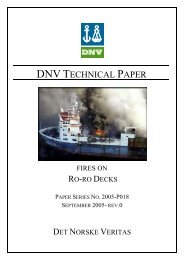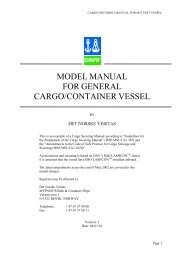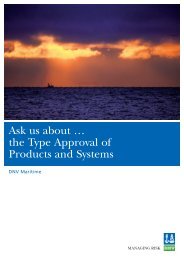InSitu Analysis of Pipeline Metallurgy - dnV
InSitu Analysis of Pipeline Metallurgy - dnV
InSitu Analysis of Pipeline Metallurgy - dnV
You also want an ePaper? Increase the reach of your titles
YUMPU automatically turns print PDFs into web optimized ePapers that Google loves.
from a pipe having a nominal original wall thickness <strong>of</strong> 4.78 mm (0.188) inches represents a localizedthickness reduction <strong>of</strong> only 10.6% <strong>of</strong> the wall thickness. The example below illustrates the effect <strong>of</strong> themetal removal on the integrity <strong>of</strong> a hypothetical pipeline.Pipe specification: API 5L X42O.D.: 219 mm (8.625 in.)Wall thickness: 4.78 mm (0.188 in.)Diameter <strong>of</strong> metal loss: 152 mm (6 in.)Depth <strong>of</strong> metal removal: 0.5 mm (0.02 in.)Calculated failure pressure using the effective area method <strong>of</strong> RSTRENG: 114% SMYSFor the hypothetical example <strong>of</strong> removing filings from a thin wall pipe, no repair would be required otherthan recoating the exposed steel since the failure pressure exceeds the SMYS. The same metal losson thicker wall pipe would be even less significant.The surface area and depth <strong>of</strong> metal removal required to collect the required mass <strong>of</strong> steel filings foranalysis can be approximated from Equation 3.M req / (16.39 cm 3 /in 3 x 7.86 gm/cm 3 ) = L x W x d (3)Where: M req = milligrams <strong>of</strong> filings required for analysisL = length <strong>of</strong> area from which filings are removed (in.)W = Width <strong>of</strong> area from which filings are removed (in.)d = depth <strong>of</strong> removal (after removal <strong>of</strong> 10 mils) (mils)Hardness TestingHardness testing on pipelines can be performed for a variety <strong>of</strong> purposes, including:Evaluating the acceptability <strong>of</strong> “hard spots” on pipe surfacesChecking weld heat affected zone hardnessChecking ERW seams and other seams for evidence <strong>of</strong> effective postweld heat treatmentEstimating tensile strength and lower bound yield strengthHard heat affected zones can be subject to cracking from exposure to fluids containing H 2 S (i.e., “sourservice”) or from the combined presence <strong>of</strong> sufficient amounts <strong>of</strong> stress, hydrogen from welding, andhard microstructures (i.e., “hydrogen cracking” or “underbead cracking”).Several types <strong>of</strong> field-portable hardness testers are available for determining the acceptability <strong>of</strong> hardspots, weld heat affected zones, or for determining the lower bound expected yield strength. However,each hardness tester has its own strengths and limitations. For example, results from some hardnesstest methods are significantly influenced by technique, material thickness, surface curvature andsurface preparation and may even be affected by residual magnetism, vibration, or temperature. 7One <strong>of</strong> the most obvious differences among different hardness test methods pertains to the volume <strong>of</strong>the metal that is sampled by the indentation. The indentations produced by a telebrineller have aspherical cap pr<strong>of</strong>ile that may be a few millimeters across, thus making them suitable for measuring thegeneral hardness <strong>of</strong> an area, but unsuitable for measuring the maximum hardness <strong>of</strong> a weld heataffected zone. In contrast, the pyramid shaped indentations associated with the ultrasonic compact(UCI) method may be barely visible to the unaided eye (Figures 9 and 10).





